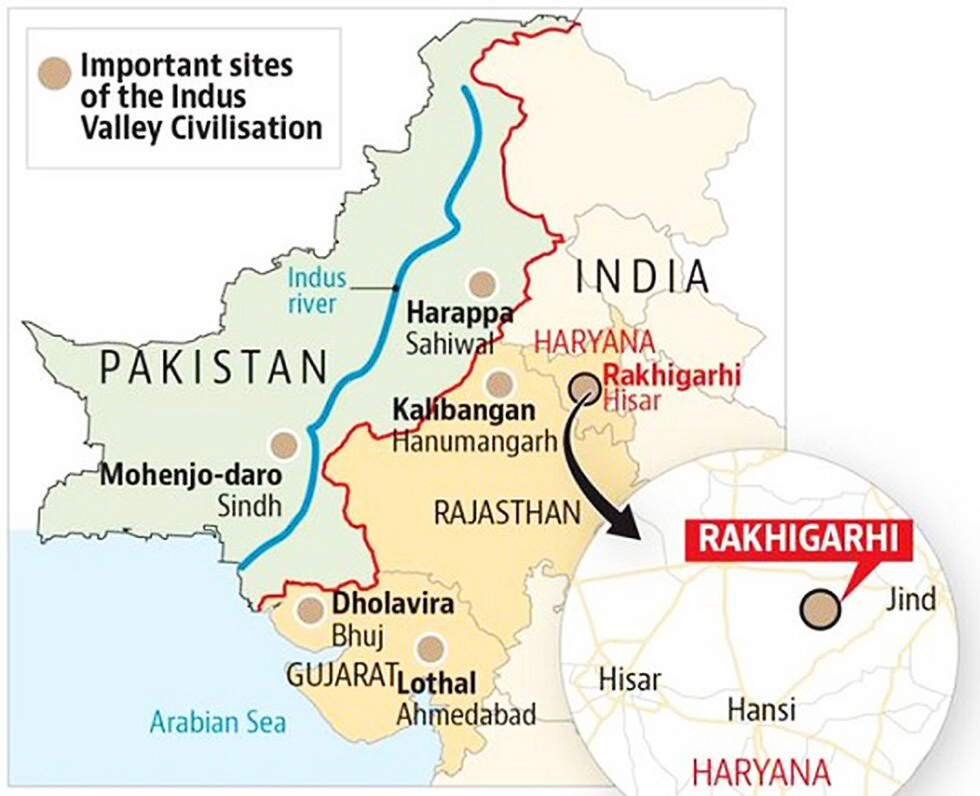Indus Valley Diet | 12 Dec 2020
Why in News
As per a study published in the Journal of Archaeological Science, the diet of the people of Indus Valley civilization had a dominance of meat, including extensive eating of beef.
Key Points
- The study, “Lipid residues in pottery from Indus Civilisation in northwest India’’, looks at the food habits of the people on the basis of lipid residue analysis found in pottery from sites such as:
- Alamgirpur (Meerut), Uttar Pradesh
- Haryana:
- Masudpur, LohariRagho, Rakhigarhi city (Hisar)
- Khanak (Bhiwani), Farmana town(Rohtak)
- Findings:
- The study finds the dominance of animal products such as meat of pigs, cattle, buffalo, sheep and goat, as well as dairy products, from rural and urban settlements of Indus Valley civilisation.
- Out of Domestic Animals, cattle/buffalo are the most abundant, averaging between 50-60% of the animal bones found, with sheep/goat accounting for 10% animal remains.
- The High Proportions of cattle bones may suggest a cultural preference for beef consumption across Indus populations, supplemented by consumption of mutton/lamb.
- At Harappa, 90% of the cattle were kept alive until they were three or three-and-a-half years, suggesting that females were used for dairy production, whereas males were used for traction.
- Previously there have been many studies on the food habit in Indus Valley civilisation before, primarily focusing on crops.
Indus Valley Civilization
- Time Period:
- The Indus Valley Civilization was established around 3300 BC. It flourished between 2600 BC and 1900 BC. It started declining around 1900 BC and disappeared around 1400 BC.
- This is also called Harappan Civilization after the first city to be excavated, Harappa (Punjab, Pakistan).
- Geographical Extent:
- Geographically, this civilization covered Punjab, Sindh, Baluchistan, Rajasthan, Gujarat and Western Uttar Pradesh.
- It extended from Sutkagengor (in Baluchistan) in the West to Alamgirpur (Western UP) in the East; and from Mandu (Jammu) in the North to Daimabad (Ahmednagar, Maharashtra) in the South. Some Indus Valley sites have also been found in as far away as Afghanistan.
- Geographically, this civilization covered Punjab, Sindh, Baluchistan, Rajasthan, Gujarat and Western Uttar Pradesh.
- Important Sites:
- Kalibangan (Rajasthan), Lothal, Dholavira, Rangpur, Surkotda (Gujarat), Banawali (Haryana), Ropar (Punjab).
- In Pakistan: Harappa (on river Ravi), Mohenjodaro (on Indus River in Sindh), Chanhudaro (in Sindh).
- Some Important Features:
- The Indus Valley cities show a level of sophistication and advancement not seen in other contemporary civilizations.
- Urban Features:
- Most cities had similar patterns. There were two parts: a citadel and the lower town showing presence of hierarchy in society.
- Most cities had a Great Bath.
- There were also granaries, 2-storied houses made of burnt bricks, closed drainage lines, excellent stormwater, and wastewater management system, weights for measurements, toys, pots, etc.
- A large number of seals have been discovered.
- Agriculture:
- The first civilization to cultivate cotton.
- Animals were domesticated like sheep, goats, and pigs.
- Crops were wheat, barley, cotton, ragi, dates, and peas.
- Trade was conducted with the Sumerians (Mesopotamia).
- Metal Products :
- These were produced including those with copper, bronze, tin, and lead. Gold and silver were also known.
- Iron was not known to them.
- Religious Beliefs:
- No structures like temples or palaces have been found.
- The people worshipped male and female deities.
- A seal which was named ‘Pashupati Seal’ has been excavated and it shows an image of a three-eyed figure.
- Pottery:
- Excellent pieces of red pottery designed in black have been excavated.
- Faience was used to make beads, bangles, earrings, and vessels.
- Art Forms:
- A statuette named ‘Dancing Girl’ has been found from Mohenjodaro and is believed to be 4000 years old.
- A figure of a bearded Priest-King has also been found from Mohenjodaro.
- Lothal was a dockyard.
- Disposal of the dead was by burial in wooden coffins.
- The Indus Valley script has not yet been deciphered.

